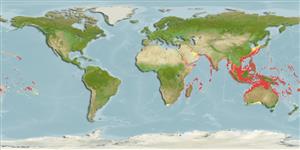Teleostei (teleosts) >
Carangiformes (Jacks) >
Carangidae (Jacks and pompanos) > Caranginae
Etymology: Caranx: French, carangue, the name of a Caribbean fish; 1836 (Ref. 45335).
More on author: Forsskål.
Environment: milieu / climate zone / depth range / distribution range
Ecology
Marine; brackish; reef-associated; depth range 10 - 188 m (Ref. 58302). Tropical; 26°C - 29°C; 35°N - 37°S, 19°E - 129°W
Indo-Pacific: Red Sea and east coast of Africa to the Hawaiian and Marquesan islands, north to southern Japan (Ref. 559) and the Ogasawara Islands, south to northern Australia. Hybrid with Caranx melampygus found in Hawaii (Ref. 58422).
Length at first maturity / Size / Weight / Age
Maturity: Lm 60.0 range ? - ? cm
Max length : 170 cm TL male/unsexed; (Ref. 9710); common length : 100.0 cm TL male/unsexed; (Ref. 5213); max. published weight: 80.0 kg (Ref. 4795)
Dorsal spines (total): 9; Dorsal soft rays (total): 18 - 21; Anal spines: 3; Anal soft rays: 15 - 17; Vertebrae: 24. This species is distinguished by the following characters: gill rakers (including rudiments) 5-7 + 15-17 = 20-24; breast naked ventrally, typically with a small to large patch of prepelvic scales; colour in life of adults, head and body silvery grey to black above, usually paler below; fins usually uniformly grey to black, fish from turbid coastal waters often with yellow fins, the anal fin usually brightest (Ref. 9894).
Adults are pelagic over sand and rock (Ref. 58302). They occur singly and inhabit clear lagoon and seaward reefs (Ref. 9710). They feed on crustaceans (like crabs and spiny lobsters) and fishes at night (Ref. 4887). Juveniles are found in estuaries. Large individuals may be ciguatoxic. The largest trevally reaches 1.7 m in length and a weight of over 60 kg (Ref. 48635). Spawning occurs on shallow seaward reefs and offshore banks (Ref. 37816). Sold mostly fresh and dried salted.
Life cycle and mating behavior
Maturity | Reproduction | Spawning | Eggs | Fecundity | Larvae
Paxton, J.R., D.F. Hoese, G.R. Allen and J.E. Hanley, 1989. Pisces. Petromyzontidae to Carangidae. Zoological Catalogue of Australia, Vol. 7. Australian Government Publishing Service, Canberra, 665 p. (Ref. 7300)
IUCN Red List Status (Ref. 130435: Version 2024-2)
Threat to humans
Reports of ciguatera poisoning (Ref. 9710)
Human uses
Fisheries: commercial; aquaculture: commercial; gamefish: yes; aquarium: public aquariums
Tools
Special reports
Download XML
Internet sources
Estimates based on models
Preferred temperature (Ref.
123201): 21.2 - 28.4, mean 26.8 °C (based on 1154 cells).
Phylogenetic diversity index (Ref.
82804): PD
50 = 0.5000 [Uniqueness, from 0.5 = low to 2.0 = high].
Bayesian length-weight: a=0.01778 (0.01493 - 0.02118), b=2.96 (2.93 - 2.99), in cm total length, based on LWR estimates for this species (Ref.
93245).
Trophic level (Ref.
69278): 4.2 ±0.4 se; based on diet studies.
Generation time: 13.7 ( na - na) years. Estimated as median ln(3)/K based on 2
growth studies.
Resilience (Ref.
120179): Medium, minimum population doubling time 1.4 - 4.4 years (K=0.08-0.11; tm=3.5).
Prior r = 0.56, 95% CL = 0.37 - 0.83, Based on 2 data-limited stock assessments.
Fishing Vulnerability (Ref.
59153): High to very high vulnerability (74 of 100).
Climate Vulnerability (Ref.
125649): High to very high vulnerability (72 of 100).
Nutrients (Ref.
124155): Calcium = 10.8 [4.6, 21.4] mg/100g; Iron = 0.288 [0.152, 0.572] mg/100g; Protein = 20.1 [17.8, 22.6] %; Omega3 = 0.122 [0.069, 0.211] g/100g; Selenium = 62.5 [30.3, 131.1] μg/100g; VitaminA = 56.9 [15.4, 194.6] μg/100g; Zinc = 0.476 [0.338, 0.698] mg/100g (wet weight);
